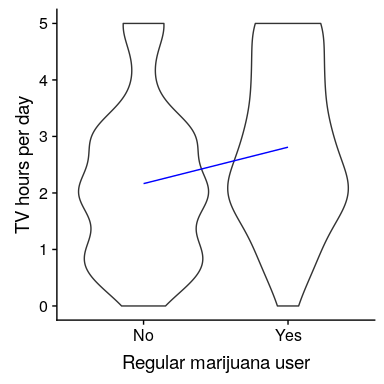## 15.2 t 檢驗作為線性模型
t 檢驗是比較平均值的一種專用工具,但也可以看作是一般線性模型的一種應用。在這種情況下,模型如下所示:

然而,吸煙是一個二元變量,因此我們將其作為一個 _ 虛擬變量 _,正如我們在上一章中討論的那樣,將其設置為吸煙者為 1,不吸煙者為零。在這種情況下,只是兩組之間平均值的差,是編碼為零的組的平均值。我們可以使用`lm()`函數來擬合這個模型,并看到它給出與上面的 t 檢驗相同的 t 統計量:
```r
# print summary of linear regression to perform t-test
s <- summary(lm(TVHrsNum ~ RegularMarij, data = NHANES_sample))
s
```
```r
##
## Call:
## lm(formula = TVHrsNum ~ RegularMarij, data = NHANES_sample)
##
## Residuals:
## Min 1Q Median 3Q Max
## -2.810 -1.165 -0.166 0.835 2.834
##
## Coefficients:
## Estimate Std. Error t value Pr(>|t|)
## (Intercept) 2.165 0.115 18.86 <2e-16 ***
## RegularMarijYes 0.645 0.213 3.02 0.0028 **
## ---
## Signif. codes: 0 '***' 0.001 '**' 0.01 '*' 0.05 '.' 0.1 ' ' 1
##
## Residual standard error: 1.4 on 198 degrees of freedom
## Multiple R-squared: 0.0441, Adjusted R-squared: 0.0393
## F-statistic: 9.14 on 1 and 198 DF, p-value: 0.00282
```
我們還可以以圖形方式查看 lm()結果(參見圖[15.2](#fig:ttestFig)):

圖 15.2 顯示每組數據的小提琴圖,藍色線連接每組的預測值,根據線性模型的結果計算。
在這種情況下,不吸煙者的預測值為(2.17),吸煙者的預測值為(2.81)。
為了計算這個分析的標準誤差,我們可以使用與線性回歸完全相同的方程——因為這實際上只是線性回歸的另一個例子。事實上,如果將上述 t 檢驗中的 p 值與大麻使用變量的線性回歸分析中的 p 值進行比較,您會發現線性回歸分析中的 p 值正好是 t 檢驗中的 p 值的兩倍,因為線性回歸分析正在執行雙尾測試。
### 15.2.1 比較兩種方法的效果大小
兩種方法之間比較最常用的效果大小是 Cohen's D(如您在第[10](#ci-effect-size-power)章中所記得的),它是用標準誤差單位表示效果的表達式。對于使用上文概述的一般線性模型(即使用單個虛擬編碼變量)估計的 t 檢驗,其表示為:

我們可以從上面的分析輸出中獲得這些值,得出 d=0.47,我們通常將其解釋為中等大小的效果。
我們也可以計算這個分析的,它告訴我們看電視的差異有多大。這個值(在 lm()分析的摘要中報告)是 0.04,這告訴我們,雖然效果在統計上有顯著意義,但它在電視觀看方面的差異相對較小。
- 前言
- 0.1 本書為什么存在?
- 0.2 你不是統計學家-我們為什么要聽你的?
- 0.3 為什么是 R?
- 0.4 數據的黃金時代
- 0.5 開源書籍
- 0.6 確認
- 1 引言
- 1.1 什么是統計思維?
- 1.2 統計數據能為我們做什么?
- 1.3 統計學的基本概念
- 1.4 因果關系與統計
- 1.5 閱讀建議
- 2 處理數據
- 2.1 什么是數據?
- 2.2 測量尺度
- 2.3 什么是良好的測量?
- 2.4 閱讀建議
- 3 概率
- 3.1 什么是概率?
- 3.2 我們如何確定概率?
- 3.3 概率分布
- 3.4 條件概率
- 3.5 根據數據計算條件概率
- 3.6 獨立性
- 3.7 逆轉條件概率:貝葉斯規則
- 3.8 數據學習
- 3.9 優勢比
- 3.10 概率是什么意思?
- 3.11 閱讀建議
- 4 匯總數據
- 4.1 為什么要總結數據?
- 4.2 使用表格匯總數據
- 4.3 分布的理想化表示
- 4.4 閱讀建議
- 5 將模型擬合到數據
- 5.1 什么是模型?
- 5.2 統計建模:示例
- 5.3 什么使模型“良好”?
- 5.4 模型是否太好?
- 5.5 最簡單的模型:平均值
- 5.6 模式
- 5.7 變異性:平均值與數據的擬合程度如何?
- 5.8 使用模擬了解統計數據
- 5.9 Z 分數
- 6 數據可視化
- 6.1 數據可視化如何拯救生命
- 6.2 繪圖解剖
- 6.3 使用 ggplot 在 R 中繪制
- 6.4 良好可視化原則
- 6.5 最大化數據/墨水比
- 6.6 避免圖表垃圾
- 6.7 避免數據失真
- 6.8 謊言因素
- 6.9 記住人的局限性
- 6.10 其他因素的修正
- 6.11 建議閱讀和視頻
- 7 取樣
- 7.1 我們如何取樣?
- 7.2 采樣誤差
- 7.3 平均值的標準誤差
- 7.4 中心極限定理
- 7.5 置信區間
- 7.6 閱讀建議
- 8 重新采樣和模擬
- 8.1 蒙特卡羅模擬
- 8.2 統計的隨機性
- 8.3 生成隨機數
- 8.4 使用蒙特卡羅模擬
- 8.5 使用模擬統計:引導程序
- 8.6 閱讀建議
- 9 假設檢驗
- 9.1 無效假設統計檢驗(NHST)
- 9.2 無效假設統計檢驗:一個例子
- 9.3 無效假設檢驗過程
- 9.4 現代環境下的 NHST:多重測試
- 9.5 閱讀建議
- 10 置信區間、效應大小和統計功率
- 10.1 置信區間
- 10.2 效果大小
- 10.3 統計能力
- 10.4 閱讀建議
- 11 貝葉斯統計
- 11.1 生成模型
- 11.2 貝葉斯定理與逆推理
- 11.3 進行貝葉斯估計
- 11.4 估計后驗分布
- 11.5 選擇優先權
- 11.6 貝葉斯假設檢驗
- 11.7 閱讀建議
- 12 分類關系建模
- 12.1 示例:糖果顏色
- 12.2 皮爾遜卡方檢驗
- 12.3 應急表及雙向試驗
- 12.4 標準化殘差
- 12.5 優勢比
- 12.6 貝葉斯系數
- 12.7 超出 2 x 2 表的分類分析
- 12.8 注意辛普森悖論
- 13 建模持續關系
- 13.1 一個例子:仇恨犯罪和收入不平等
- 13.2 收入不平等是否與仇恨犯罪有關?
- 13.3 協方差和相關性
- 13.4 相關性和因果關系
- 13.5 閱讀建議
- 14 一般線性模型
- 14.1 線性回歸
- 14.2 安裝更復雜的模型
- 14.3 變量之間的相互作用
- 14.4“預測”的真正含義是什么?
- 14.5 閱讀建議
- 15 比較方法
- 15.1 學生 T 考試
- 15.2 t 檢驗作為線性模型
- 15.3 平均差的貝葉斯因子
- 15.4 配對 t 檢驗
- 15.5 比較兩種以上的方法
- 16 統計建模過程:一個實例
- 16.1 統計建模過程
- 17 做重復性研究
- 17.1 我們認為科學應該如何運作
- 17.2 科學(有時)是如何工作的
- 17.3 科學中的再現性危機
- 17.4 有問題的研究實踐
- 17.5 進行重復性研究
- 17.6 進行重復性數據分析
- 17.7 結論:提高科學水平
- 17.8 閱讀建議
- References
